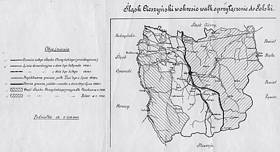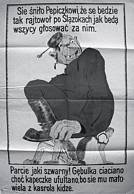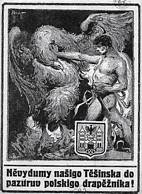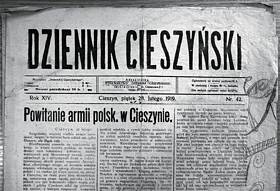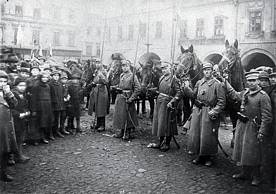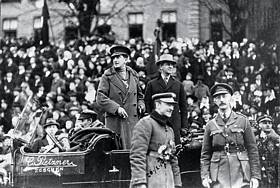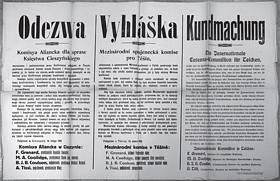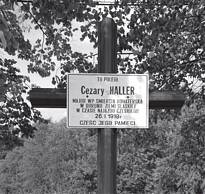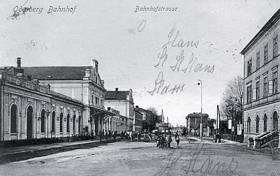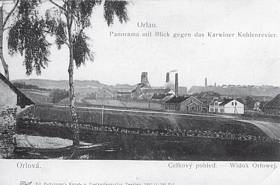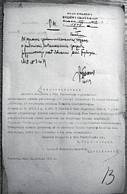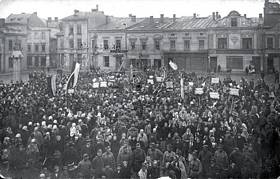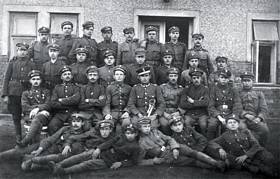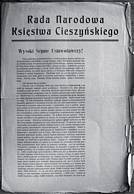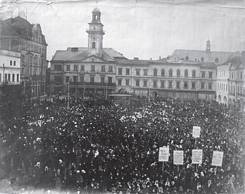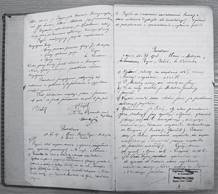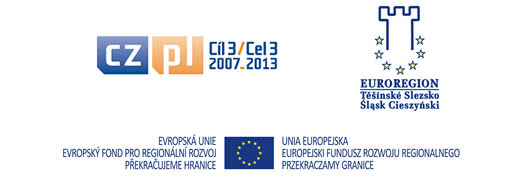The First Independence
90 years ago the monarchies and the thrones of the Austrian Habsburgs, Prussian-German Hohenzollerns and Russian Romanovs were collapsing. New states were either emerging or coming back into being from the ruins of imperial Austria-Hungary, Germany and Russia.
A group of Polish activists set up the National Council for the Duchy of Cieszyn (also referred to here as the National Council: in Polish – Rada Narodowa Księstwa Cieszyńskiego) in Cieszyn on 19 October 1918. The council’s name drew from the traditions of the Piast dynasty in Cieszyn Silesia. It was the first organized and independent Polish government of territories inhabited by Poles to be established before the First World War ended.
The creation of the National Council by the Polish population in autumn 1918 established a form of state government which was there for the asking in the region bounded by Bielsko, Cieszyn and Frýdek. During those first, decisive moments following the collapse of the old Austria the Poles turned out to be the quickest and best organized. The dynamic beginnings of the National Council and the subsequent integration of Cieszyn Silesia into the Republic of Poland, re-emerging after 123 years of bondage, was not a short-lived impulse. It was the crowning achievement of the Polish nationalistic movement, which had been evolving for over 50 years and resulted from the numerical superiority of the Polish ethnic community. The movement, which after the Spring of Nations in 1848 was led by Paweł Stalmach, Father Ignacy Świeży and Reverend Franciszek Michejda with the help of numerous collaborators, was formed by political parties such as the ZŚK (the Association of Silesian Catholics), the PZN (the Polish National Union) and the PPSD (the Polish Social Democratic Party); as well as numerous community, economic and cultural organizations. Standing out among them were Macierz Szkolna (the Polish nationalistic educational and cultural organisation) and the newspapers Gwiazdka Cieszyńska and Dziennik Cieszyński. The founding of the Polish gymnasium in Cieszyn in 1895 and the Polish gymnasium in Orlová in 1909 were symbolic events in the Polish nationalistic movement. In 1914 men of the Silesian Legions set off from Cieszyn to fight on the Russian front. In total 600 of them served in the Polish Legions. Despite the casualties and obstacles thrown up by the war, it was apparent that there were well-organized Polish forces capable of decisive action in the context of the political transformations which were soon to occur to in Cieszyn and the region.
The disorientation of Cieszyn’s Austrian-German population – who had found themselves on the losing side in autumn 1918 – created favourable conditions for the National Council for the Duchy of Cieszyn to begin assuming power. The Czech population, outnumbered by the Poles and poorly organized, were still weak. However, the early work of the Council was not made easier by the general political situation outside Cieszyn Silesia, particularly in Galicia and the Polish Kingdom, where no Polish government had been established which was fully independent of the former occupying powers. On 27 October 1918 during a rally staged by the National Council – which was also an expression of support by the local population for the establishment of Polish government – a crowd of several thousand Poles announced:
We, Poles of the Duchy of Cieszyn, gathered here on 27 October 1918 at a patriotic rally in Cieszyn Market Square, officially declare:
- Since the victorious idea of justice acknowledged by all the nations of the world has resurrected a free, independent and united Poland with its own coastline, we, Poles of the Duchy of Cieszyn, recognize our individual right and the right of our region to belong to Poland. We pledge the Republic of Poland our allegiance, obedience, property and blood. We will not accept any opposing bonds against these bounden duties.
- We demand that the entire Polish nation act with utmost haste and vigour to come to the defence of Poles in Spisz and Orawa (today the Slovakian regions of Spią and Orava) and make a determined stand to bring about the incorporation of those Polish territories into Poland once and for all.
- We demand that a Constitutional Sejm including the representatives of all Polish territories, elected in general, fair, direct voting by secret ballot by both men and women be summoned in Warsaw as soon as possible.
- The Constitutional Sejm should implement such social reforms for Poland in order that she become the Mother to a wide panoply of citizens, with neither oppressors nor oppressed, with no class privileges, but such that personal and civil liberty in every respect remain intact. This land, governed by the nation, shall belong to those that toil on it with large tracts of forestry remaining the property of the nation. Coal mines, transport, and those branches of manufacturing industry, banking and commerce of particular national significance should be nationalized. Universal, free state education must be made available to the younger generation. Wide-ranging social welfare and a guarantee of the 8-hour working day in industry and mining will protect the health and strength of working people.
- In gaining national unification and state independence, we acknowledge the aspirations of every nation in its struggle for its own statehood. In particular we desire to live in harmony and good terms with the Czech nation. The social conditions and national development of national minorities living in Poland must be protected. 6. We categorically state that we, Poles, consider ourselves the sole rulers of Cieszyn Silesia and solemnly swear that we will never surrender this region and will defend it with all our strength against any hostile designs.
The composition of the National Council was a compromise reflecting the political, community and religious diversity of the Polish population of Cieszyn Silesia. The representatives of the three local political parties; Father Józef Londzin (ZŚK), Jan Michejda (PZN) and Tadeusz Reger (PPSD) were elected Presidents of the Council. Each party delegated 7 members to the Council, including one woman. The number of members of the Council varied. Midway through 1919 it was 34. Apart from the presidents at various times the following people sat on the Council: Leon Wolf, Karol Junga, Wacław Olszak, Father Eugeniusz Brzuska, Jan Mirocha, Józef Mola, Franciszek Tomiczek, Franciszek Halfar, Maria Sojkowa (ZŚK), Kazimierz Piątkowski, Tadeusz Michejda, Feliks Hajduk, Jan Szuścik, Paweł Bobek, Paweł Lazar, Jan Sztwiertnia, Jan Kotas, Jan Jaś, Jan Kawulok, Zofia Kirkor-Kiedroniowa (PZN, later PSL – the Polish Peoples’ Party), Ryszard Kunicki, Jerzy Kantor, Ludwik Lizak, Engelbert Wawreczka, Wiktor Sembol, Piotr Kornuta, Franciszek Czyż, Józef Machej, Edward Parchański, Jan Papuga, Ferdynand Goetze, Andrzej Teller, Dorota Kłuszyńska (PPSD, later PPS – the Polish Socialist Party). Władysław Jeziorski of the small ZSN (the National and Community Association) and the journalist Bolesław Włodek were also members of the Council. Paweł Bobek became the Council’s secretary. Until 10 November the Council held its meetings in Dom Narodowy (the National House) and later in Cieszyn Castle.
The Polish authorities came up against their first difficulties by the end of October 1918 with the proclamation of an independent Czechoslovakia on 28 October in Prague. The following day the Czechoslovakian Provincial National Council for Silesia (in Czech - Zemský Národní Výbor pro Slezsko) was formed, which began to issue identical postulates to the National Council for the Duchy of Cieszyn. The Czechoslovakian side attempted to assume power in the Fryątát administrative region, but envoys of the National Council for the Duchy of Cieszyn managed to prevent that. As a result, the National Council officially stated on 30 October:
that it solemnly proclaims the national affiliation of the Cieszyn Duchy to a free, independent and united Poland and assumes state control over it. Considering the aspirations of the Czech nation the National Council for the Duchy of Cieszyn states that the establishing of permanent borders between the fraternal Polish and Czech nations should be left to be established by the two governments; the Polish Government in Warsaw and the Czech Government in Prague, with a deep conviction that in establishing the borders the governments should be informed by genuine national affiliation and the will of the people.
On the same day the majority of Polish borough leaders of the Cieszyn region swore an oath of allegiance to the National Council which read:
I swear before God Almighty that I will forthwith acknowledge the National Council of the Duchy of Cieszyn being the organ of the Polish Government as the rightful State Authority and I swear allegiance and obedience, to conscientiously fulfil all its orders and instructions, as befits a decent citizen and faithful servant of the Fatherland. So help me God!
On the night of 31 October Polish officers of the Cieszyn garrison in clandestine contact with the National Council took control of the garrison, bringing the rest of the national defence regiment under the control of the Polish authorities. The Cieszyn starosta Zygmunt Żurawski and the Bielsko starosta Jakub Podczaski submitted to the leaders of the National Council. During the following few days Polish forces took over other military garrisons. The period of now only formal Polish-Austrian joint government was over. On 2 November the National Council informed the Regency Council in Warsaw and the Polish Liquidation Commission in Krakow (established on 28 October) about the seizure of power in Cieszyn Silesia.
The transferring of the remaining government offices and institutions in the region into Polish hands lasted another two weeks or so. The National Council not only became the representative of the Polish population but acted as the state government: with autonomic, legislative and executive powers over all its citizens. On 4 November the National Council established a Polish Militia under the command of Jerzy Szczurek. In a published announcement the National Council declared that:
The keeping of peace and harmony are essential so as not allow the spread of insidious confusion by irresponsible factors and thus protect the country from the threat of destruction which many countries have endured. The National Council hereby appeals not only to the Polish population, but also to all national minorities in Poland, since the harmonious cooperation of all is in the interests of both the general population and each of the nationalities living in Cieszyn Silesia.
An accord was reached between the National Council and the Czechoslovakian Provincial National Council for Silesia on 5 November, as a consequence of which temporary borders for Cieszyn Silesia were drawn up which were based on ethnic criteria. In this way the greater part of the region came under the control of the National Council; i.e. the Bielsko and Cieszyn powiats (administrative districts), and a considerable fragment of the Fryątát powiat, while the Frýdek powiat, the majority of whose population was Czech and which the Poles laid no claim to came under the government of the Provincial National Council for Silesia. According to earlier pronouncements made by the National Council the final drawing up of the borders was to be carried out by the Polish and Czechoslovakian governments. The Czechoslovakian government in Prague began by accepting the new situation, even though it in principle was demanding control over the whole of Cieszyn Silesia as the historical “Lands of the Bohemian Crown of Saint Wenceslas”.
The National Council administered Cieszyn Silesia through the following departments: Executive; Socio-Political; Taxation; Accounting; Mining, Industrial and Commercial; numerous commissions and offices. There was a Delegation of the National Council for the Coalfield. In December the National Government for the Duchy of Cieszyn was established with Jan Michejda appointed to lead it, which assumed some of the Council’s administrative responsibilities.
,br />
The establishment of a constituency in Cieszyn Silesia for the elections to the Legislative Sejm announced for 26 January 1919 was evidence of the wish of the newly-formed central administration in Warsaw to incorporate Cieszyn Silesia in Poland.
An attack by the Czechoslovakian army interrupted the almost three-month period of being Polish in Cieszyn, Bielsko, Skoczów and Strumień; and also Karviná, Fryątát and Jablunkov and their rural surroundings. The attack on 23 January 1919 was an assault on the Polish zone, juxtaposing military might against the wishes of the majority of the local population. The November border agreement no longer satisfied Prague, which was hoping to gain all the heavy industry in Cieszyn Silesia and the Cieszyn branch of the Koąice-Bohumín railway line, linking Bohemia with Slovakia. Czech economic claims, even though they concerned ethnically Polish regions, became the basis of Prague’s policy with regard to the Cieszyn Question in the following months. An open Polish-Czech conflict blew up, which made its appearance on the international scene during the talks of the Paris Peace Conference. The 5 November deal was forgotten, and the aspirations of the National Council – representing the majority of the population of Cieszyn Silesia and Poland – were pushed into the background by the Western Powers. Subsequent attempts to achieve political compromises ended in farce. The plebiscite announced by the Supreme Council of the Paris Peace Conference in September 1919 never took place. The fate of the Cieszyn region was sealed by the territorial division of the Council of Ambassadors in Paris on 28 July 1920 which set the Polish-Czechoslovakian border on the River Olza. This result of this was that over one hundred thousand Poles found themselves outside the borders of Poland and with them a centre of Polish cultural life which had been cultivated for decades.
The First Polish Independence – i.e. the fruits of the efforts of Cieszyn Poles in autumn 1918 in the border regions of the re-emerging Poland – deserves to be acknowledged and remembered. In a very short space of time the local Polish population, who could not rely on help from the outside, built the foundations of Polish statesmanship which was to function with reasonable success for the next few months. Before the armistice on the First World War’s Western Front and before the first totally free government of the Republic of Poland was ushered in in Warsaw, the red and white flags of Poland were flying in the small town of Cieszyn.
This year’s Independence Day celebrations and publications are dedicated to the memory of these momentous events.
Translated by Biuro Tłumaczeń SHERWOOD
Photographs and documents in this publication come from:
- The Museum of Cieszyn Silesia
- The Cieszyn Historical Library
- The State Archives in Katowice, Cieszyn Branch
- Cieszyn, Czeski Cieszyn na starych widokówkach i fotografiach, H. Wawreczka, J. Spyra, and M. Makowski. Wart: Nebory 1999

